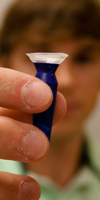The Eyes Have It
When a team of undergrads announced the results of their senior research project, there wasn’t a dry eye in the house. Literally. The five NC State biomedical engineering (BME) students had developed a special lens for patients suffering from forms of paralysis that leave them unable to blink and hydrate their eyes.
Their revolutionary concept won first place in a national contest for undergraduate researchers in their field, along with a $10,000 prize, and may lead to future relief for paralysis sufferers. The idea, said Alex McGaughy (’10), came from a hospital patient the students saw who had suffered an injury that affected his ability to blink.
“The nurses were constantly applying drops, Vaseline and covering his eyes with Saran Wrap to keep them hydrated,” said McGaughy, who will graduate in December. “We found that this also happened to burn victims, or people with Bell’s palsy, a condition that paralyzes certain muscles in the face.”

McGaughy, along with fellow teammates Eli Pollack, Roya Nezarati, Elizabeth Kirk and Trinh Doan, had all expressed an interest in neurology as the subject of their senior project. Their advisor, Dr. Andrew DiMeo, put them together and sent them to WakeMed hospital to find a problem to solve.
“In the BME program, the senior project is always to find a real-world problem, figure out how to address it and to go through the same steps that you would if you were developing something for a hospital or a corporation,” said Pollack, who graduated in May with a B.S. in biomedical engineering.
The team spoke with nurses and doctors in the neurology unit at WakeMed, as well as family members of patients and the Boston Foundation for Sight. With a little help from these sources and lab space from Aerie Pharmaceuticals, the team eventually created the HydrEye CorneOasis, a special hybrid contact lens that fits over the eye and holds moisture against it, preventing the eye from drying out.
“That’s one of the real differences in this biomedical engineering program,” DiMeo said. “We don’t provide the students with problems and say, ‘Go fix this.’ We try to make this experience as much like the real world as possible.
“Students identify the problem, propose solutions, and then go through the phases of product development just like they will if they work in the medical industry.”
While the team was working on its project, DiMeo encouraged them to enter the BMEStart competition, a brand-new, undergraduate-only competition modeled after one of the nation’s most prestigious design competitions for graduate students in biomedical engineering. The undergraduate contest drew competitors from around the country in its inaugural year.
At least part of the team’s winnings will go toward continued work on the HydrEye project by graduate students in BME, since the original team members have all moved on to other schools or jobs.
“This work is important,” says Pollack, “so we don’t want to just leave it on the shelf.”
- Categories:


